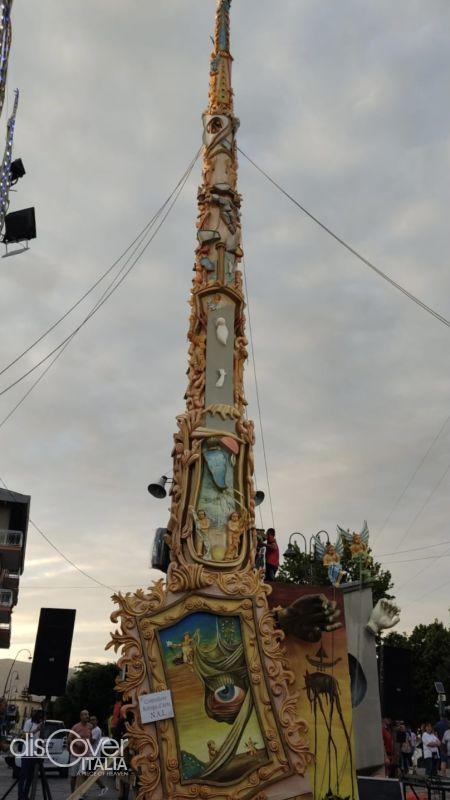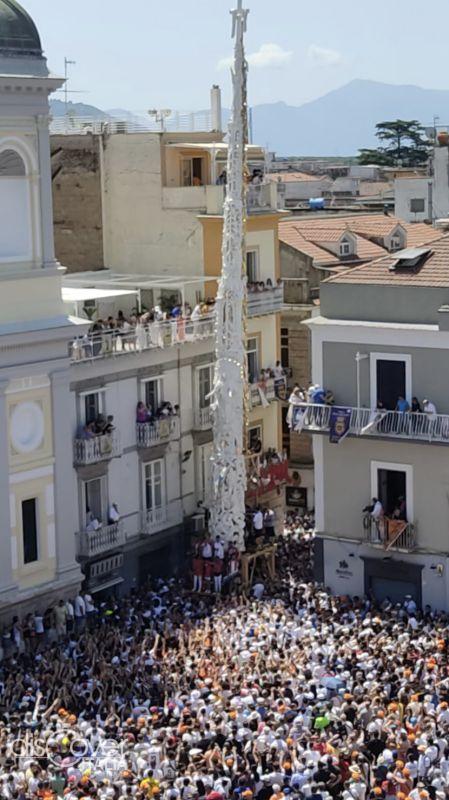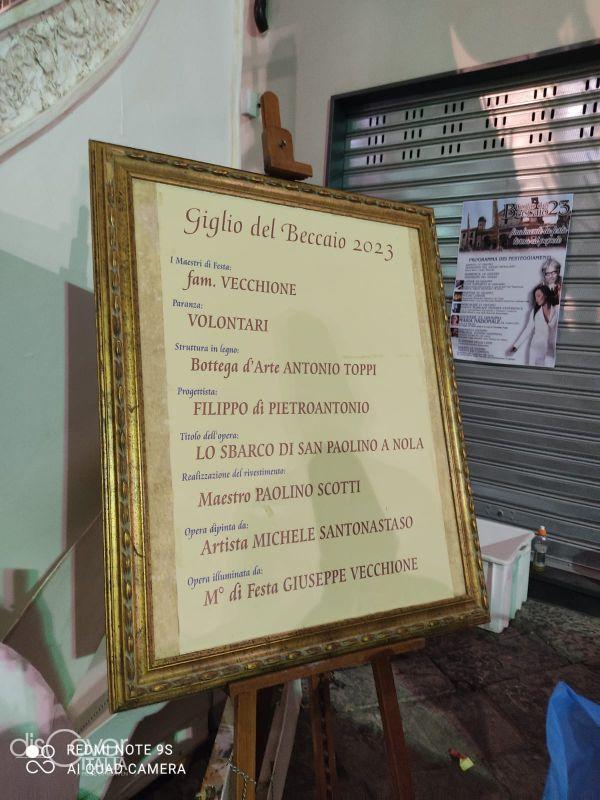From the top of the bell towers on the sides of the neoclassical façade of the cathedral dedicated to the Madonna Assunta, the statues of the patron saints dominate the large square, the heart of the city of Nola.
 There is San Felice, born in Nola, and there is San Paolino, to whom the ancient festival is dedicated. A manifestation of faith that since 2013 has entered the oral and intangible Heritage of Humanity. Merit of the imposing wooden and papier-mache obelisks that are the protagonists and which are part of the Network of Italian backpack machines recognized and protected by UNESCO. Since the nineteenth century, that is the shape that Lilies have taken. With them seventeen centuries ago the people of Nola greeted the return of their beloved Bishop Paulinus. The event that is still remembered every year by the entire Nola community, involved in its preparation over the previous twelve months.
There is San Felice, born in Nola, and there is San Paolino, to whom the ancient festival is dedicated. A manifestation of faith that since 2013 has entered the oral and intangible Heritage of Humanity. Merit of the imposing wooden and papier-mache obelisks that are the protagonists and which are part of the Network of Italian backpack machines recognized and protected by UNESCO. Since the nineteenth century, that is the shape that Lilies have taken. With them seventeen centuries ago the people of Nola greeted the return of their beloved Bishop Paulinus. The event that is still remembered every year by the entire Nola community, involved in its preparation over the previous twelve months.
The Festival of the Lilies is a strongly identifying element, which is renewed every 22 June and which attracts visitors from all over the world to Nola. The fulcrum of the event is Piazza Duomo, where, on the morning of the feast day, the eight twenty-five meter high "Lilies" and the boat arrive. All those are fundamental elements of the solemn commemoration of that distant, unspecified day between 411 and 412 AD.
A riot of lilies for the return of Paolino
 The Nolans no longer hoped to see their beloved Bishop alive again. In 409, Nola had been the victim of the invasion of the Goths led by Alaric, who had brought death and destruction. And to complete the work, they had taken twenty-one prisoners, including a widow's little son. Faced with that last outrage, Paolino, to try to save the child, handed over all his possessions and himself. He was thus taken as a slave to Algeria, where he began to work as a gardener. One night he dreamed of the king's death and told his master, who brought him before the king to tell the premonition. The king was so frightened that, determined to remove that slave, he undertook to accept any of his requests. Paolino asked to be released with his fellow citizens and obtained his freedom. Disembarked with his other adventure companions - on the beach of Torre Annunziata, according to another reconstruction between history and legend - Paolino was welcomed with great enthusiasm. With the members of the guilds of arts and crafts in the front row, there was a jubilation of lilies to celebrate the return of the bishop safe and sound.
The Nolans no longer hoped to see their beloved Bishop alive again. In 409, Nola had been the victim of the invasion of the Goths led by Alaric, who had brought death and destruction. And to complete the work, they had taken twenty-one prisoners, including a widow's little son. Faced with that last outrage, Paolino, to try to save the child, handed over all his possessions and himself. He was thus taken as a slave to Algeria, where he began to work as a gardener. One night he dreamed of the king's death and told his master, who brought him before the king to tell the premonition. The king was so frightened that, determined to remove that slave, he undertook to accept any of his requests. Paolino asked to be released with his fellow citizens and obtained his freedom. Disembarked with his other adventure companions - on the beach of Torre Annunziata, according to another reconstruction between history and legend - Paolino was welcomed with great enthusiasm. With the members of the guilds of arts and crafts in the front row, there was a jubilation of lilies to celebrate the return of the bishop safe and sound.
Paolino, the Bishop by the will of the people
Son of the prefect of Aquitaine, Pontius Meropius Paulinus was born in 353-354 in Burdigala, today's Bordeaux, and had received a solid education and the suitable preparation to undertake the cursus honorum required by his family's position. So, at twenty he was already a senator. At the end of the assignment, in 379 he had been designated governor of Campania, but instead of settling in Capua, he had chosen to go to Nola, where he had properties. In that city he learned of the deeply rooted cult of San Felice in the places where he had lived. When leaving Nola, with a pagan ceremony he cut his beard, dedicating the gesture to San Felice. He then returned to Aquitania, where he settled and where, after meeting her in Spain during a trip, he brought his young wife Teresia, who was a Christian. By her he had a son, Celsus, who died a few days after his birth. It was after this tragedy that he approached Christianity until his conversion. He was baptized at the age of thirty-five, donated his wealth and with his wife they dedicated themselves to the monastic life. Paolino embarked on the path of priesthood and was ordained in 393-395. With Teresia they returned to Nola, where Paolino founded a male and a female cenoby. There he dedicated himself to building a new church for San Felice and some structures to welcome pilgrims devoted to the Saint from Nola and did many good works. Author of an important epistolary, he exchanged letters with Augustine of Hippo of whom he was a friend. He made himself loved by the population, who, under the threat of the advance of the Goths, acclaimed him Bishop in 409. Shortly thereafter he gave himself up as a prisoner to the invading barbarians.
The relics and the cult in the Cathedral
 After his return, Paolino remained in Nola, increasingly attached to San Felice, to whom he dedicated one of his "Christmas carols" every year, on the day of his death. And he died in that city on June 22, 431. His body, initially buried in the basilica of San Felice, then transferred to Rome, was definitively transferred to the cathedral of Nola in 1908, shortly before the new church, completely rebuilt after the fire which in February 1861 had devastated the ancient Gothic cathedral, was inaugurated in 1909.
After his return, Paolino remained in Nola, increasingly attached to San Felice, to whom he dedicated one of his "Christmas carols" every year, on the day of his death. And he died in that city on June 22, 431. His body, initially buried in the basilica of San Felice, then transferred to Rome, was definitively transferred to the cathedral of Nola in 1908, shortly before the new church, completely rebuilt after the fire which in February 1861 had devastated the ancient Gothic cathedral, was inaugurated in 1909.
Among the few vestiges that escaped the fire, with the crypt and the chapel of the Immaculate, the rebuilt cathedral also houses the seventeenth-century wooden statues of San Felice and San Paolino, works by Iacopo Bonavitaand his workshop. Of the six chapels in the left aisle, one of the three remaining in the new cathedral is dedicated to San Paolino, with paintings by Vincenzo Severino.
Also kept in the cathedral is the silver bust of the bishop, which is carried in procession on 22 June, on the day of the solemn and well-attended annual celebrations.
The gigantic Lilies Unesco heritage
A characteristic element of the festival are the Lilies, a sign of devotion to the Saint, together with the boat, which recalls the vehicle that brought him back to Italy after slavery. Originally, on the day of the commemoration of Paolino's ascent to heaven, flowers were used. The return to Nola of the future saint was greeted with lilies, typical of the season. Then we moved on to the candles, which have been replaced over time by increasingly complex and imposing wooden structures, up to the gigantic obelisks that retain only the name of the original flower.
Hand in hand with the transformation of the lilies, an increasingly elaborate and well-defined ceremonial has evolved. It concerns both the preparatory phase of the festival and the key event on 22 June.
The organization of the celebrations begins a few days after the archiving of the previous edition. The fulcrum is always Piazza Duomo, because it is in the town hall that the ceremony of assigning the "lily" to the new master of celebration takes place. There is a master for each of the nine guilds that participate in the parade, always in the same order.

The Nolan shoulder machines are formed by a basic structure of wooden poles, which must allow the overlying part of the actual "lily" to be moved. That is composed of a wooden core, "dressed" with decorative papier-mache stuccos, which represent religious, historical or current scenes.
The master also takes care of the organization of the parade of each Lily and chooses the men of the "paranza" who will have to make them move. Considering the weight, which exceeds twenty quintals, the considerable height, the length of the event and the difficulties of the long route, at least 128 men "cullatori" are needed for each Lily.
The Day of the Lilies
It all begins in the square in front of the Cathedral, where on the morning of the 22nd the eight Lilies and the boat are brought for the Bishop's blessing. In the afternoon the parade begins along a wide pre-established itinerary in the heart of the city. The "cullatori" move the individual lilies by swaying, following the rhythm of the musical pieces specially chosen and performed by the band. The itinerary presents many critical points and imposes as many tests of ability to the "paranze". It goes on for the rest of the day, until the following morning. When the Giglio del Sarto(Taylor’s Lily), which closes the parade, reaches the square, the feast ends and the structures, "stripped" of the decorations, are dismantled.
A few days later, work began on the new festival in honor of the patron saint of Nola, who has also been the secondary patron saint of Campania since 2016.





Comments powered by CComment